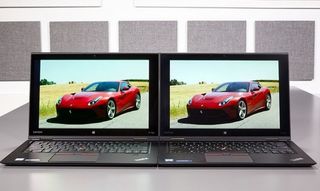ThinkPad X1 Yoga's New OLED Screen: Brilliant Color Brings Images to Life
We recently got the new ThinkPad X1 Yoga with OLED display into our Labs, and we were eager to check out how the screen stacks up. After all, this is just the second OLED laptop we've seen so far (the first being the Alienware 13). Luckily, we still had one of the non-OLED X1 Yogas in the lab, so we put them head to head. Our test results and subjective experience show that OLED is a game changer that's definitely worth the premium.

Update 8/29: We have refined our testing for OLED displays. This article has been updated to reflect and explain the results.
We reviewed the ThinkPad X1 Yoga with non-OLED screen in March with a 1080p display and were impressed with its ability to covered 102 percent of the sRGB color gamut. The average 14-inch laptop only reaches 92 percent of the gamut , while many other business laptops such as the ThinkPad X260 (68 percent) don't even crack 70 percent. We were big fans of this screen and touted its accurate skin tones and white balance.
However, the 2560 x 1440 OLED display is in a different league, covering an astounding 201.9 percent of the sRGB gamut. This means that it can show twice as many different shades as the default panel.
MORE: Best Lenovo Laptops
When we measured the display with a full white screen, it averaged a brightness of 236 nits. This is because OLED screens tend to dim when there are a lot of white pixels being shown. With just a small window of white pixels on the screen, it measured a much brighter average of 305 nits.
| ThinkPad X1 Yoga Displays: Test Results | ||
| Benchmark | OLED Screen | Regular Screen |
| Brightness | 236 / 305 nits | 279 nits |
| Color Gamut (sRGB) | 201.9 percent | 102 percent |
| Color Accuracy (Delta e) | 2.24 | 0.6 |
When I watched the latest trailer for "Rogue One: A Star Wars Story" on both screens simultaneously, the numbers didn't matter -- OLED won me over. Red lasers were brighter and green bushes were more vivid. There was more life in Jyn Erso's eyes. The sky was a crisper, clearer blue.
Stay in the know with Laptop Mag
Get our in-depth reviews, helpful tips, great deals, and the biggest news stories delivered to your inbox.
The battery life was less noticeably less than on the 1080p version of the X1 Yoga, but about on par with the other 2560 x 1440 unit we tested. The 1920 x 1080 model lasted 8 hours and 38 minutes on the Laptop Battery Test, which involves continuous surfing over Wi-Fi. However, the number shrunk down to 7:52 on a model with a non-OLED 2K screen and got a nearly identical time of 7:40 on the OLED version. The higher screen resolution, rather than the OLED technology is likely the reason that this unit got about an hour less battery life than the base model.
You will pay a premium for the OLED display, with a ThinkPad that has the panel starting at $1,402 while the base model costs just $1,162 with a 1080p display but similar specs. However, the vibrant colors are well worth the trade-off in price and battery life.
Check out our full review of the X1 Yoga with OLED and non-OLED displays to learn more about this Editor's Choice winning 2-in-1.
